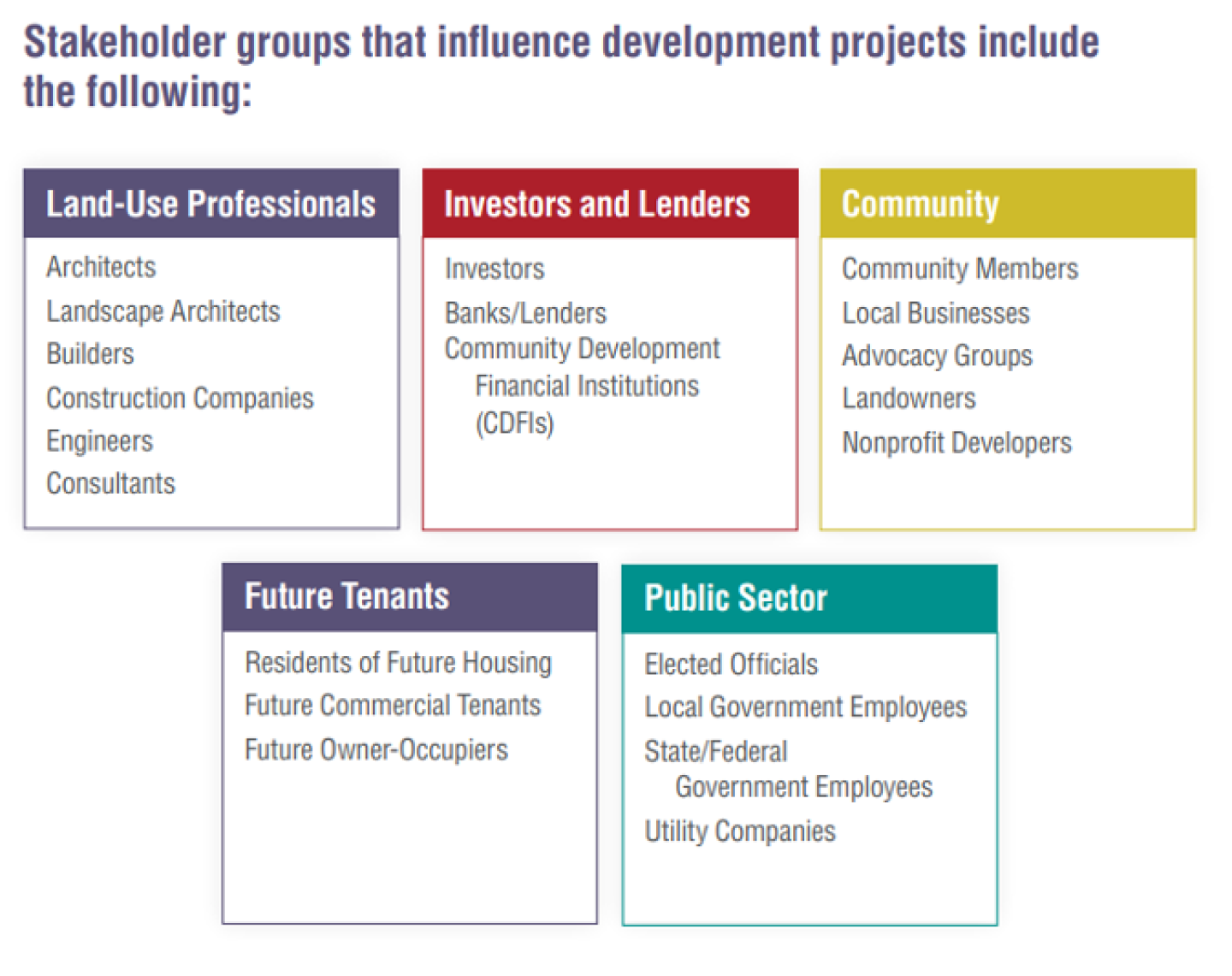Nearly everyone in the United States lives in a home, shops in stores, works in offices, or otherwise engages with spaces that were created, at some point, by a developer—someone who played a major role in determining the mix of stores, homes, employment opportunities, public spaces, and other features present in a community.
The mechanics of planning and building a major development may be familiar to real estate professionals, but the entire process can be opaque and intimidating to laypersons in the communities most directly affected. ULI’s new report, Development for Nondevelopers, aims to bridge that knowledge gap. It offers a clear, practical guide to how development projects come together—and how communities can assure the project ultimately meets local needs.
“Development for Nondevelopers provides an overview of the real estate development process, aiming to help community members and public-sector leaders engage effectively,” says report contributor Rico Quirindongo, director of the City of Seattle Office of Planning and Community Development. “The report highlights the potential benefits of development, such as economic prosperity and improved infrastructure, while acknowledging the risks and historical negative outcomes like displacement of under-served populations. It emphasizes the importance of collaboration and understanding among stakeholders to ensure projects contribute positively to communities.”
A user-friendly guide to a complex process
A better grasp of the development process—from financing to permitting to construction—can help community members and elected officials advocate for their neighborhoods, whether it’s new housing, a grocery store, or a renovated park. Development for Nondevelopers was created to assist in understanding a developer’s perspective so that community input can be more productive from the outset. It’s intended for non-real estate people who may not speak the language of pro formas and capital stacks—but want and need to understand how it all works.
The ULI report:
- Offers an overview of the real estate development process;
- Breaks down financing basics, timelines, and development risks;
- Explains how community engagement, zoning, and regulations shape projects; and
- Draws on insights from both developers and nondevelopers across the country.
The report walks lay readers through key concepts—from feasibility studies to entitlements to how funding sources affect project timelines and features—while also showing how local decisions and community voices can lead to better outcomes.
“Development for Nondevelopers is a clear, practical, and engaging breakdown of how real estate development actually works,” says Eric Manuel, director at ARCH Capital Management Co. “It’s perfect for local officials trying to align projects with community goals, students or career-switchers curious about the development process, nonprofit leaders or advocates pushing for more inclusive urban growth, and anyone who’s ever asked, ‘Why is that building taking so long to finish?’”
The main sections of the report include:
- Development basics, including an overview of what developers do, descriptions of real estate product types, drivers of development activity, stages of the development process, stakeholder groups that influence development, and factors that influence development outcomes.
- Development potential, including how development can advance community priorities, centering community voices in decision-making, reconciling competing priorities, considerations related to centering, and more.
- Economic considerations, including project risks for both developers and communities, common sources of capital, and the role of investors, market factors, and project timelines.
- Regulatory factors, including how regulations influence development, the role of zoning, development incentives, and more.
- Community engagement, including strategies for constructive engagement in the development process, potential benefits of effective community engagement on project outcomes, community benefits agreements, and more.
Exploring development potential
Development for Nondevelopers explores the potential of real estate development as a catalyst to benefit surrounding communities. When done thoughtfully, a project can generate jobs, increase community well-being, and improve the local infrastructure that allows neighborhoods to thrive.
“Real estate development plays an essential role in funding, building, and rehabilitating critical infrastructure—parks, transportation systems, schools, and more,” says Jenni Morejon, president and CEO of the Fort Lauderdale Downtown Development Authority. “This is generally not well understood—the fact that development can support the creation of valuable public assets that improve quality of life.”
Yet development can also have negative consequences. Historically, it has contributed to racial and economic segregation. Throughout the 20th century, exclusionary zoning, redlining, and discriminatory investment decisions deprived many Black families of opportunities to build wealth through home ownership—a sorry legacy that still shapes many cities today.
That’s why it’s critical for today’s projects to be guided by inclusive practices and community engagement. While real estate industry leaders have the greatest responsibility to ensure their projects contribute positively to local neighborhoods, everyone can and should play a role.
“How the community experiences working with a developer the first time sets their reputation and whether they will embrace the developer on other projects in the future,” says Treasure Sheppard, strategic initiatives project manager at the Housing Authority of the City of Los Angeles. “Including project features, stores, and amenities that the community actually wants will improve quality of life and will also support the project’s bottom line. It’s good business.”
Risk and reward
Real estate development is inherently risky. For developers, that risk includes years of upfront investment and borrowing before a single dollar of return is realized. Projects can be upended by shifting regulations, market swings, capital markets, or public opposition.
But risk exists on the community side as well. Without collaboration and thoughtful planning, new development can result in:
- Displacement, especially in areas without adequate affordable housing;
- Rising property taxes and financial pressure on long-time residents;
- Loss of cultural assets like music venues, galleries, and gathering spaces; and
- Declining community cohesion as people and businesses are forced to leave.
Understanding these risks makes it easier to design policies and partnerships that produce better outcomes—and to anticipate when trade-offs may be necessary to advance key community priorities.

Mike Miles, Laurence Netherton, and Adrienne Schmitz, Real Estate Development: Principles and Process, 5th ed. (Washington, D.C.: Urban Land Institute, 2015), knowledge.uli.org/en/books/2015/real-estate-development--5th-edition.
The role of zoning and land use regulations
Zoning and land use regulations play a major role in shaping what gets built—and where. These rules can either streamline or stall development, making projects more (or less) expensive, ultimately affecting what features make it to the finish line. Updating zoning has the potential to improve the development process and lead to more equitable outcomes.
Community groups and members are essential in this process. Advancing zoning updates can promote investment that ultimately supports goals such as green space, affordable housing, and greater walkability—and create more predictability in the development process, potentially making projects less risky financially and more likely to garner community support.
Turning insights into action
Here are some of the practical ways to use ULI’s Development for Nondevelopers report to drive better local outcomes:
- Empower community members and leaders to understand the basics of the full development lifecycle—from feasibility to financing to construction and more—and help stakeholders engage meaningfully in their neighborhoods.
- Support effective community engagement, including when and how to collaborate with developers, making it more likely that community priorities—such as bike trails or affordable housing—are woven into projects.
- Inform local decision-making, including equipping public-sector leaders and community stakeholders with insight into developer risks, incentives, and market factors, enabling more productive collaboration.
- Improve alignment of development with community goals by leveraging insights on the development process to advance projects that balance profitability with tangible community benefits.
- Strengthen public discourse on development by fostering open conversations about potential development trade-offs—such as automobile parking versus walkability and public transit—grounded in a shared understanding of development basics.
- Guide regulatory updates and zoning reform by identifying the role of zoning and other regulations in determining what type of development gets built in certain places.
- Guide aspiring developers by providing a useful map to anyone considering a career in real estate development.
Learn more at knowledge.uli.org/nondevelopers.









